Analytical Thinking and Decision Making
VerifiedAdded on 2023/01/19
|12
|2853
|39
AI Summary
This report explores the importance of decision making and its application in decision analysis. It covers the significance of decision making, different stages and approaches, theories and practices, and the role of decision makers within an organization. The report also discusses the application of the SMART technique to outline decision problems and assesses the strengths and limitations of the analysis.
Contribute Materials
Your contribution can guide someone’s learning journey. Share your
documents today.
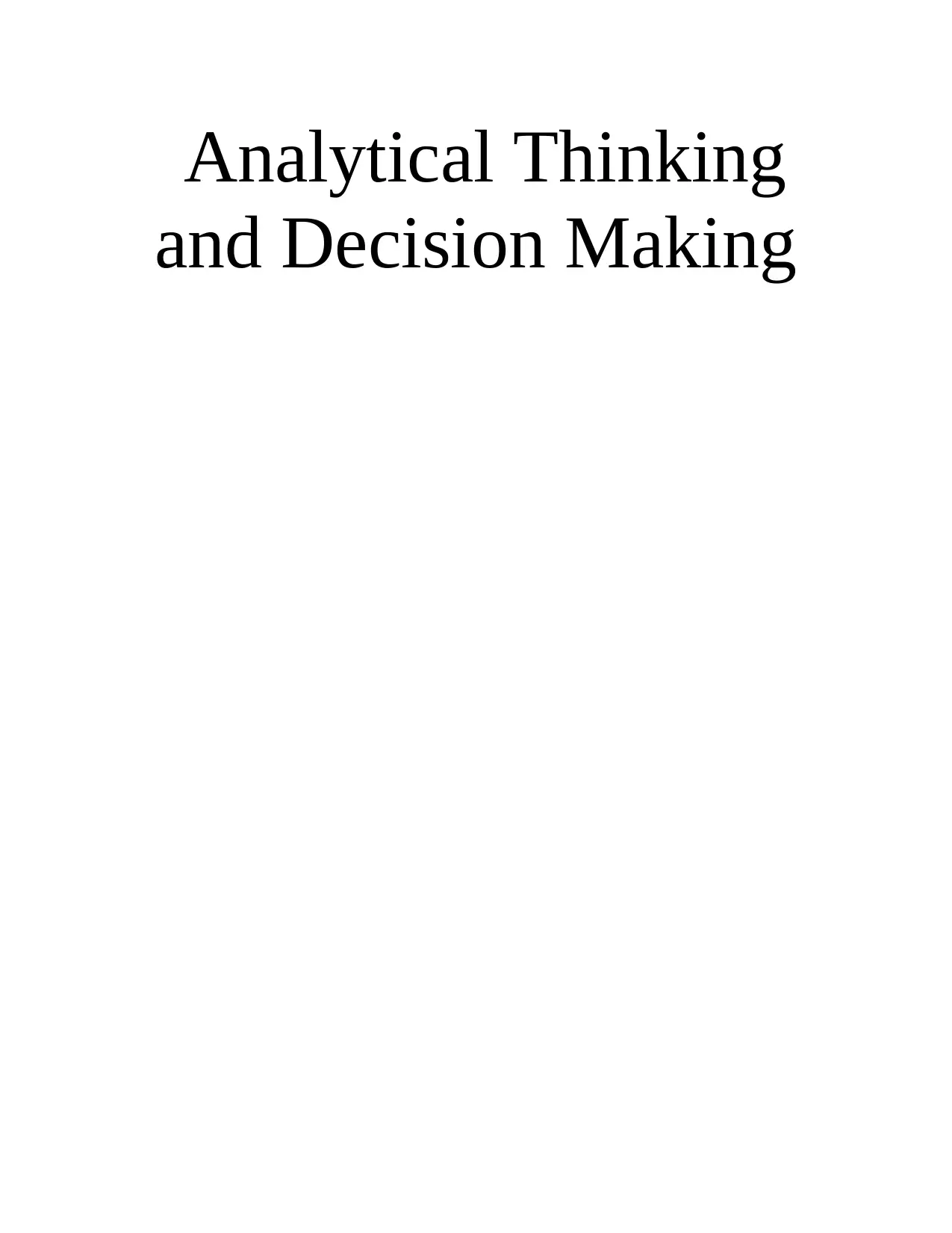
Analytical Thinking
and Decision Making
and Decision Making
Secure Best Marks with AI Grader
Need help grading? Try our AI Grader for instant feedback on your assignments.
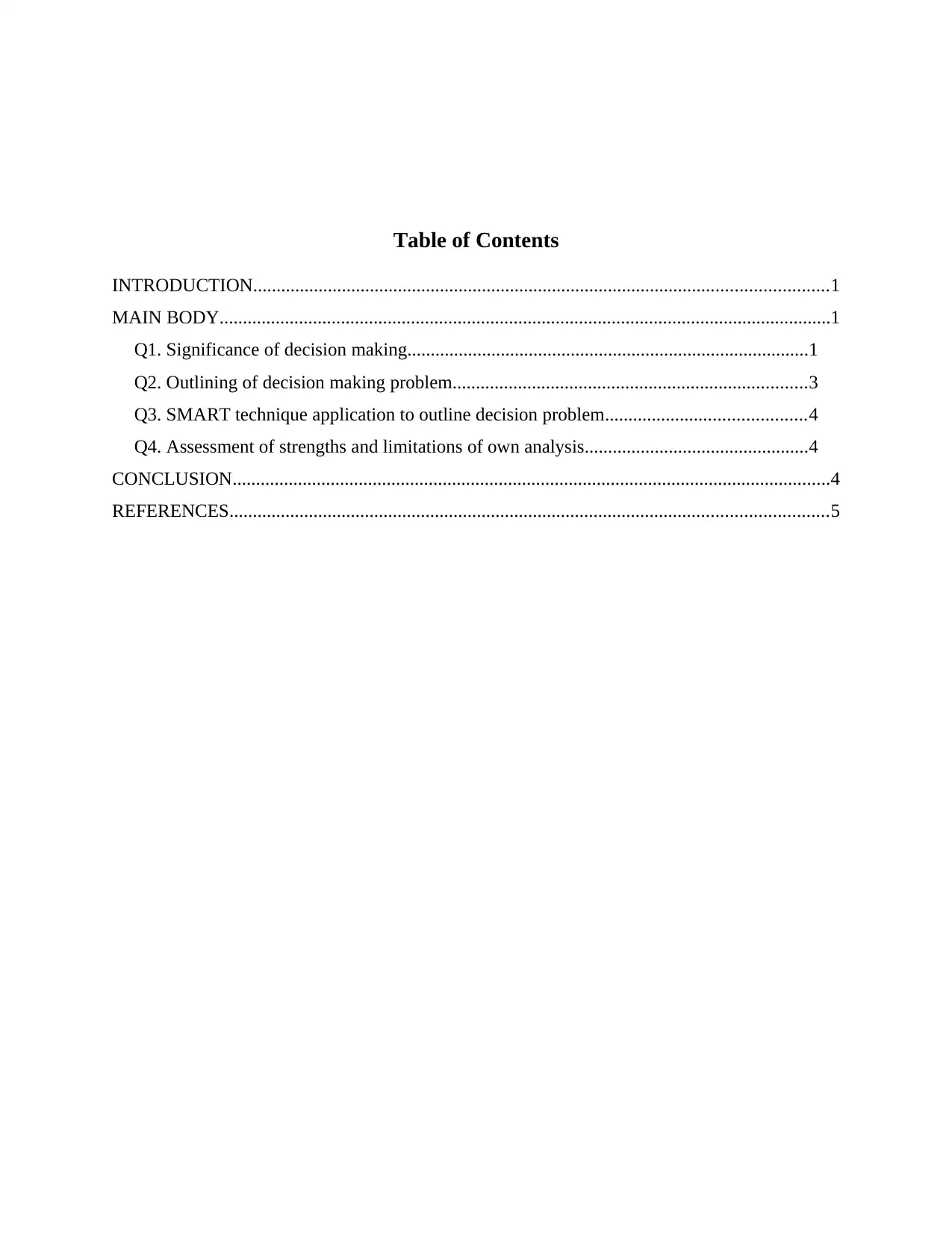
Table of Contents
INTRODUCTION...........................................................................................................................1
MAIN BODY...................................................................................................................................1
Q1. Significance of decision making......................................................................................1
Q2. Outlining of decision making problem............................................................................3
Q3. SMART technique application to outline decision problem...........................................4
Q4. Assessment of strengths and limitations of own analysis................................................4
CONCLUSION................................................................................................................................4
REFERENCES................................................................................................................................5
INTRODUCTION...........................................................................................................................1
MAIN BODY...................................................................................................................................1
Q1. Significance of decision making......................................................................................1
Q2. Outlining of decision making problem............................................................................3
Q3. SMART technique application to outline decision problem...........................................4
Q4. Assessment of strengths and limitations of own analysis................................................4
CONCLUSION................................................................................................................................4
REFERENCES................................................................................................................................5


INTRODUCTION
Analytical thinking introduces to the critical element of visual thinking that provides one the
capability to solve any kind of issue effectively and quickly. It consists a methodological step-
by-step approach or component to thinking that allow an individual to break down difficult
issues into manageable and single elements. Decision making refers to the process of making
effective choice by determining a decision, collecting data, and assessing better or alternative
solutions. Within an organisation, there are number of issues can occur, so it is the role of
business manager to deal with it in effective and quicker manner. This report is based on
different tasks that will be included importance of decision making and its application in decision
analysis. Application of SMART techniques will also cover that support business manager in
making of effective decision regarding any type of issues. At last, strength and limitation of
decision problem will also discuss under this report.
MAIN BODY
Q1. Significance of decision making
Key features of decision making
Decision making is goal oriented: Every single choice of the executives major or minor
must make, in any event, a few commitment towards the achievement of authoritative
destinations. On the off chance that something else, dynamic is an inefficient action; including
just a sheer wastage of the time, vitality and endeavours of supervisors, and valuable
authoritative assets.
Decision making is intellectual exercise: Dynamic calls for innovativeness and creative
mind with respect to directors; in that choice - making powers supervisors to think regarding
growing best goals and best options for achieving those goals.
Decision making is continuous process: Dynamic procedure initiates since the origin of
business and proceeds all through the hierarchical life. All chiefs take choices for hierarchical
Association Charts: Types, Principles, purposes; insofar as the venture is in presence. Indeed,
dynamic is additionally associated with the way toward selling or ending up a business
endeavour (Bachmann and Niemivirta, 2019).
Different stages of decision making
There are 9 different stages of decision making which are defined below:
1
Analytical thinking introduces to the critical element of visual thinking that provides one the
capability to solve any kind of issue effectively and quickly. It consists a methodological step-
by-step approach or component to thinking that allow an individual to break down difficult
issues into manageable and single elements. Decision making refers to the process of making
effective choice by determining a decision, collecting data, and assessing better or alternative
solutions. Within an organisation, there are number of issues can occur, so it is the role of
business manager to deal with it in effective and quicker manner. This report is based on
different tasks that will be included importance of decision making and its application in decision
analysis. Application of SMART techniques will also cover that support business manager in
making of effective decision regarding any type of issues. At last, strength and limitation of
decision problem will also discuss under this report.
MAIN BODY
Q1. Significance of decision making
Key features of decision making
Decision making is goal oriented: Every single choice of the executives major or minor
must make, in any event, a few commitment towards the achievement of authoritative
destinations. On the off chance that something else, dynamic is an inefficient action; including
just a sheer wastage of the time, vitality and endeavours of supervisors, and valuable
authoritative assets.
Decision making is intellectual exercise: Dynamic calls for innovativeness and creative
mind with respect to directors; in that choice - making powers supervisors to think regarding
growing best goals and best options for achieving those goals.
Decision making is continuous process: Dynamic procedure initiates since the origin of
business and proceeds all through the hierarchical life. All chiefs take choices for hierarchical
Association Charts: Types, Principles, purposes; insofar as the venture is in presence. Indeed,
dynamic is additionally associated with the way toward selling or ending up a business
endeavour (Bachmann and Niemivirta, 2019).
Different stages of decision making
There are 9 different stages of decision making which are defined below:
1
Secure Best Marks with AI Grader
Need help grading? Try our AI Grader for instant feedback on your assignments.
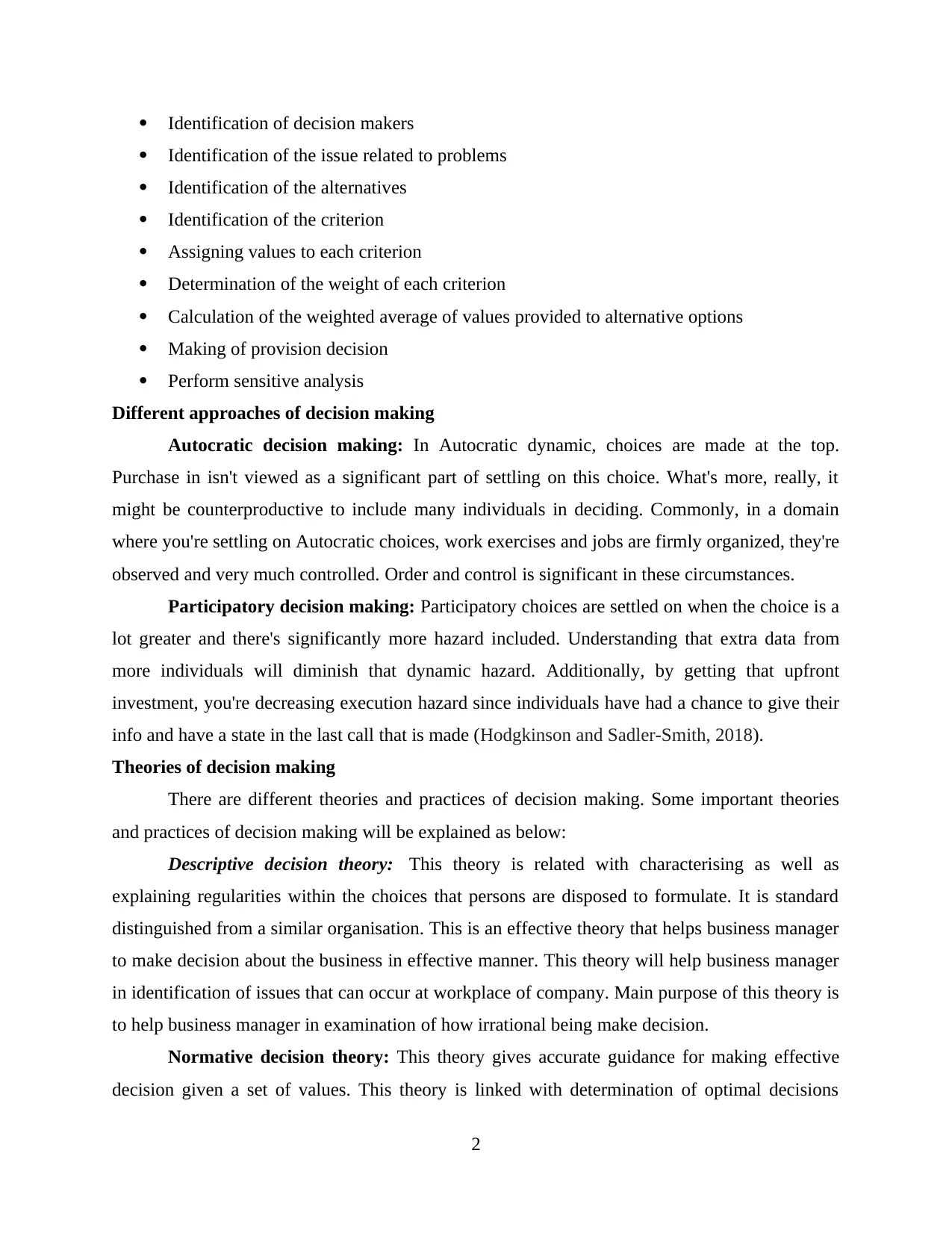
Identification of decision makers
Identification of the issue related to problems
Identification of the alternatives
Identification of the criterion
Assigning values to each criterion
Determination of the weight of each criterion
Calculation of the weighted average of values provided to alternative options
Making of provision decision
Perform sensitive analysis
Different approaches of decision making
Autocratic decision making: In Autocratic dynamic, choices are made at the top.
Purchase in isn't viewed as a significant part of settling on this choice. What's more, really, it
might be counterproductive to include many individuals in deciding. Commonly, in a domain
where you're settling on Autocratic choices, work exercises and jobs are firmly organized, they're
observed and very much controlled. Order and control is significant in these circumstances.
Participatory decision making: Participatory choices are settled on when the choice is a
lot greater and there's significantly more hazard included. Understanding that extra data from
more individuals will diminish that dynamic hazard. Additionally, by getting that upfront
investment, you're decreasing execution hazard since individuals have had a chance to give their
info and have a state in the last call that is made (Hodgkinson and Sadler-Smith, 2018).
Theories of decision making
There are different theories and practices of decision making. Some important theories
and practices of decision making will be explained as below:
Descriptive decision theory: This theory is related with characterising as well as
explaining regularities within the choices that persons are disposed to formulate. It is standard
distinguished from a similar organisation. This is an effective theory that helps business manager
to make decision about the business in effective manner. This theory will help business manager
in identification of issues that can occur at workplace of company. Main purpose of this theory is
to help business manager in examination of how irrational being make decision.
Normative decision theory: This theory gives accurate guidance for making effective
decision given a set of values. This theory is linked with determination of optimal decisions
2
Identification of the issue related to problems
Identification of the alternatives
Identification of the criterion
Assigning values to each criterion
Determination of the weight of each criterion
Calculation of the weighted average of values provided to alternative options
Making of provision decision
Perform sensitive analysis
Different approaches of decision making
Autocratic decision making: In Autocratic dynamic, choices are made at the top.
Purchase in isn't viewed as a significant part of settling on this choice. What's more, really, it
might be counterproductive to include many individuals in deciding. Commonly, in a domain
where you're settling on Autocratic choices, work exercises and jobs are firmly organized, they're
observed and very much controlled. Order and control is significant in these circumstances.
Participatory decision making: Participatory choices are settled on when the choice is a
lot greater and there's significantly more hazard included. Understanding that extra data from
more individuals will diminish that dynamic hazard. Additionally, by getting that upfront
investment, you're decreasing execution hazard since individuals have had a chance to give their
info and have a state in the last call that is made (Hodgkinson and Sadler-Smith, 2018).
Theories of decision making
There are different theories and practices of decision making. Some important theories
and practices of decision making will be explained as below:
Descriptive decision theory: This theory is related with characterising as well as
explaining regularities within the choices that persons are disposed to formulate. It is standard
distinguished from a similar organisation. This is an effective theory that helps business manager
to make decision about the business in effective manner. This theory will help business manager
in identification of issues that can occur at workplace of company. Main purpose of this theory is
to help business manager in examination of how irrational being make decision.
Normative decision theory: This theory gives accurate guidance for making effective
decision given a set of values. This theory is linked with determination of optimal decisions
2
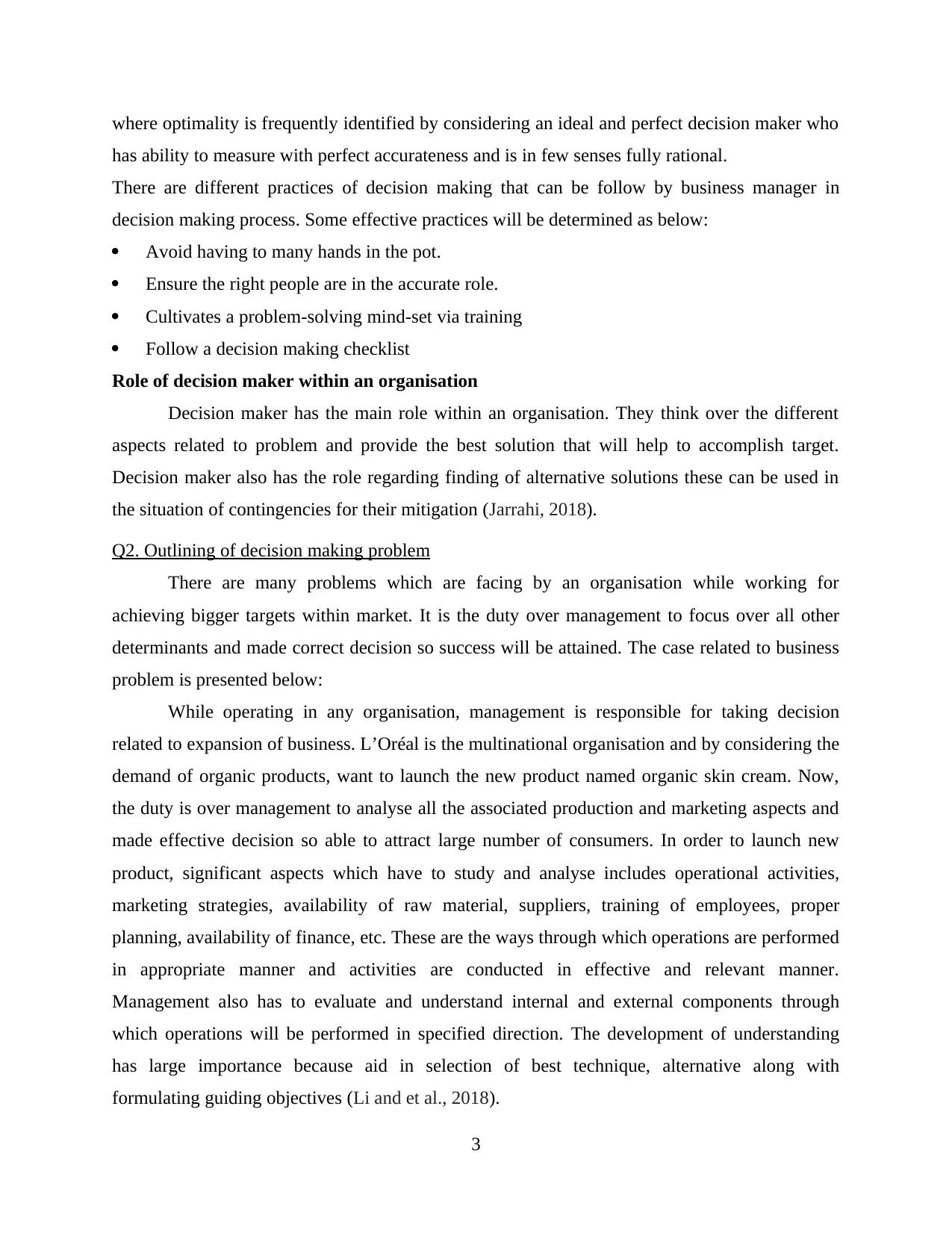
where optimality is frequently identified by considering an ideal and perfect decision maker who
has ability to measure with perfect accurateness and is in few senses fully rational.
There are different practices of decision making that can be follow by business manager in
decision making process. Some effective practices will be determined as below:
Avoid having to many hands in the pot.
Ensure the right people are in the accurate role.
Cultivates a problem-solving mind-set via training
Follow a decision making checklist
Role of decision maker within an organisation
Decision maker has the main role within an organisation. They think over the different
aspects related to problem and provide the best solution that will help to accomplish target.
Decision maker also has the role regarding finding of alternative solutions these can be used in
the situation of contingencies for their mitigation (Jarrahi, 2018).
Q2. Outlining of decision making problem
There are many problems which are facing by an organisation while working for
achieving bigger targets within market. It is the duty over management to focus over all other
determinants and made correct decision so success will be attained. The case related to business
problem is presented below:
While operating in any organisation, management is responsible for taking decision
related to expansion of business. L’Oréal is the multinational organisation and by considering the
demand of organic products, want to launch the new product named organic skin cream. Now,
the duty is over management to analyse all the associated production and marketing aspects and
made effective decision so able to attract large number of consumers. In order to launch new
product, significant aspects which have to study and analyse includes operational activities,
marketing strategies, availability of raw material, suppliers, training of employees, proper
planning, availability of finance, etc. These are the ways through which operations are performed
in appropriate manner and activities are conducted in effective and relevant manner.
Management also has to evaluate and understand internal and external components through
which operations will be performed in specified direction. The development of understanding
has large importance because aid in selection of best technique, alternative along with
formulating guiding objectives (Li and et al., 2018).
3
has ability to measure with perfect accurateness and is in few senses fully rational.
There are different practices of decision making that can be follow by business manager in
decision making process. Some effective practices will be determined as below:
Avoid having to many hands in the pot.
Ensure the right people are in the accurate role.
Cultivates a problem-solving mind-set via training
Follow a decision making checklist
Role of decision maker within an organisation
Decision maker has the main role within an organisation. They think over the different
aspects related to problem and provide the best solution that will help to accomplish target.
Decision maker also has the role regarding finding of alternative solutions these can be used in
the situation of contingencies for their mitigation (Jarrahi, 2018).
Q2. Outlining of decision making problem
There are many problems which are facing by an organisation while working for
achieving bigger targets within market. It is the duty over management to focus over all other
determinants and made correct decision so success will be attained. The case related to business
problem is presented below:
While operating in any organisation, management is responsible for taking decision
related to expansion of business. L’Oréal is the multinational organisation and by considering the
demand of organic products, want to launch the new product named organic skin cream. Now,
the duty is over management to analyse all the associated production and marketing aspects and
made effective decision so able to attract large number of consumers. In order to launch new
product, significant aspects which have to study and analyse includes operational activities,
marketing strategies, availability of raw material, suppliers, training of employees, proper
planning, availability of finance, etc. These are the ways through which operations are performed
in appropriate manner and activities are conducted in effective and relevant manner.
Management also has to evaluate and understand internal and external components through
which operations will be performed in specified direction. The development of understanding
has large importance because aid in selection of best technique, alternative along with
formulating guiding objectives (Li and et al., 2018).
3
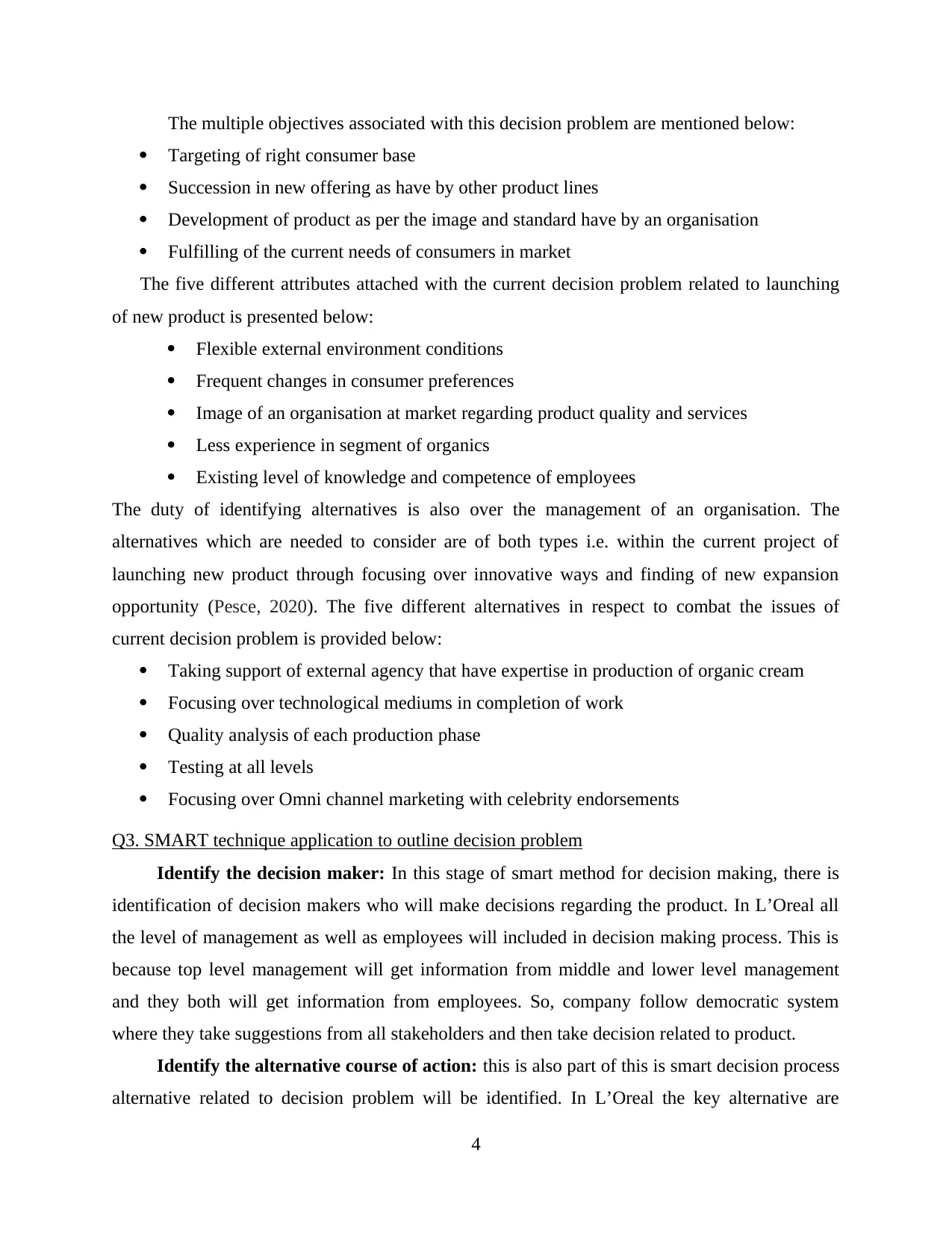
The multiple objectives associated with this decision problem are mentioned below:
Targeting of right consumer base
Succession in new offering as have by other product lines
Development of product as per the image and standard have by an organisation
Fulfilling of the current needs of consumers in market
The five different attributes attached with the current decision problem related to launching
of new product is presented below:
Flexible external environment conditions
Frequent changes in consumer preferences
Image of an organisation at market regarding product quality and services
Less experience in segment of organics
Existing level of knowledge and competence of employees
The duty of identifying alternatives is also over the management of an organisation. The
alternatives which are needed to consider are of both types i.e. within the current project of
launching new product through focusing over innovative ways and finding of new expansion
opportunity (Pesce, 2020). The five different alternatives in respect to combat the issues of
current decision problem is provided below:
Taking support of external agency that have expertise in production of organic cream
Focusing over technological mediums in completion of work
Quality analysis of each production phase
Testing at all levels
Focusing over Omni channel marketing with celebrity endorsements
Q3. SMART technique application to outline decision problem
Identify the decision maker: In this stage of smart method for decision making, there is
identification of decision makers who will make decisions regarding the product. In L’Oreal all
the level of management as well as employees will included in decision making process. This is
because top level management will get information from middle and lower level management
and they both will get information from employees. So, company follow democratic system
where they take suggestions from all stakeholders and then take decision related to product.
Identify the alternative course of action: this is also part of this is smart decision process
alternative related to decision problem will be identified. In L’Oreal the key alternative are
4
Targeting of right consumer base
Succession in new offering as have by other product lines
Development of product as per the image and standard have by an organisation
Fulfilling of the current needs of consumers in market
The five different attributes attached with the current decision problem related to launching
of new product is presented below:
Flexible external environment conditions
Frequent changes in consumer preferences
Image of an organisation at market regarding product quality and services
Less experience in segment of organics
Existing level of knowledge and competence of employees
The duty of identifying alternatives is also over the management of an organisation. The
alternatives which are needed to consider are of both types i.e. within the current project of
launching new product through focusing over innovative ways and finding of new expansion
opportunity (Pesce, 2020). The five different alternatives in respect to combat the issues of
current decision problem is provided below:
Taking support of external agency that have expertise in production of organic cream
Focusing over technological mediums in completion of work
Quality analysis of each production phase
Testing at all levels
Focusing over Omni channel marketing with celebrity endorsements
Q3. SMART technique application to outline decision problem
Identify the decision maker: In this stage of smart method for decision making, there is
identification of decision makers who will make decisions regarding the product. In L’Oreal all
the level of management as well as employees will included in decision making process. This is
because top level management will get information from middle and lower level management
and they both will get information from employees. So, company follow democratic system
where they take suggestions from all stakeholders and then take decision related to product.
Identify the alternative course of action: this is also part of this is smart decision process
alternative related to decision problem will be identified. In L’Oreal the key alternative are
4
Paraphrase This Document
Need a fresh take? Get an instant paraphrase of this document with our AI Paraphraser
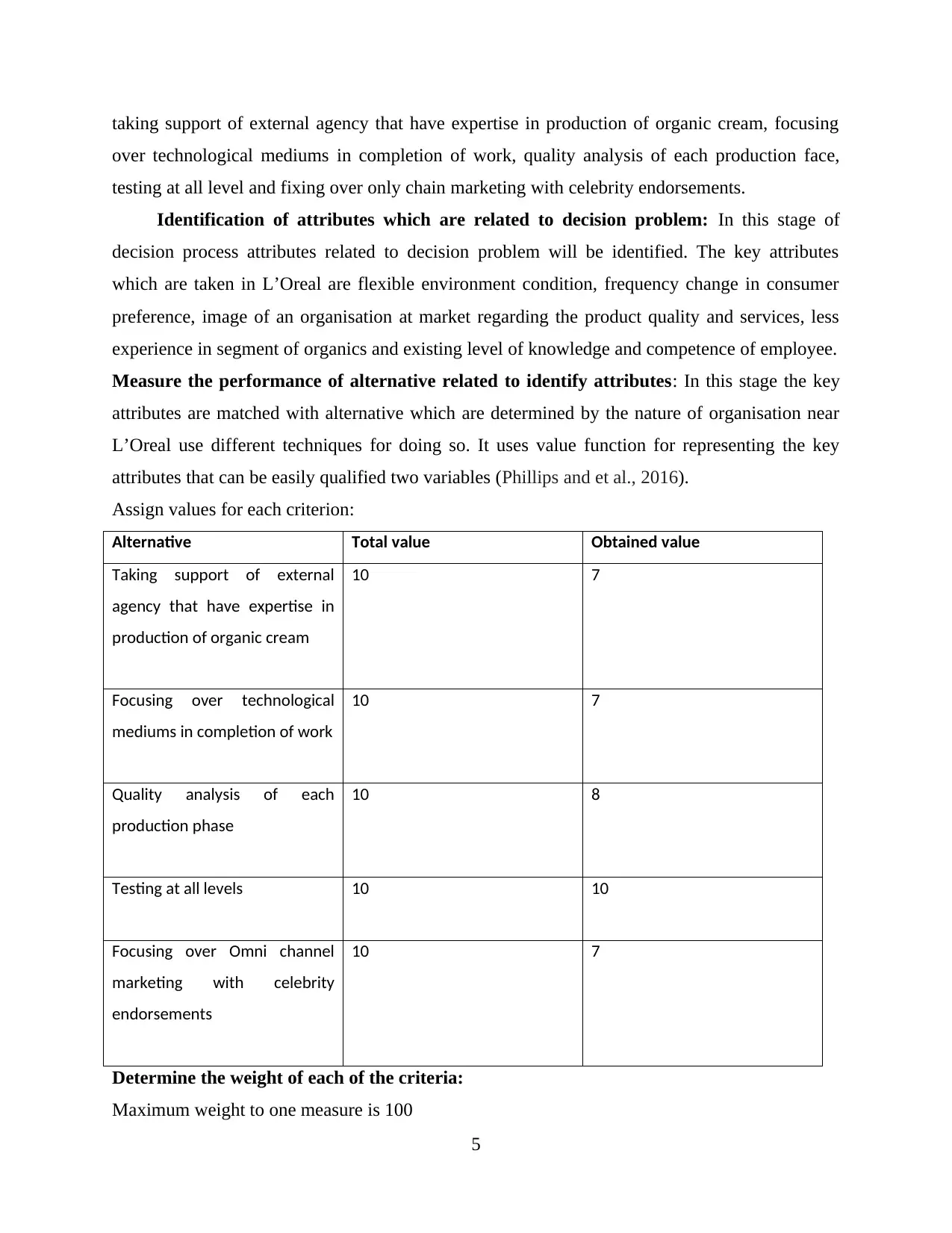
taking support of external agency that have expertise in production of organic cream, focusing
over technological mediums in completion of work, quality analysis of each production face,
testing at all level and fixing over only chain marketing with celebrity endorsements.
Identification of attributes which are related to decision problem: In this stage of
decision process attributes related to decision problem will be identified. The key attributes
which are taken in L’Oreal are flexible environment condition, frequency change in consumer
preference, image of an organisation at market regarding the product quality and services, less
experience in segment of organics and existing level of knowledge and competence of employee.
Measure the performance of alternative related to identify attributes: In this stage the key
attributes are matched with alternative which are determined by the nature of organisation near
L’Oreal use different techniques for doing so. It uses value function for representing the key
attributes that can be easily qualified two variables (Phillips and et al., 2016).
Assign values for each criterion:
Alternative Total value Obtained value
Taking support of external
agency that have expertise in
production of organic cream
10 7
Focusing over technological
mediums in completion of work
10 7
Quality analysis of each
production phase
10 8
Testing at all levels 10 10
Focusing over Omni channel
marketing with celebrity
endorsements
10 7
Determine the weight of each of the criteria:
Maximum weight to one measure is 100
5
over technological mediums in completion of work, quality analysis of each production face,
testing at all level and fixing over only chain marketing with celebrity endorsements.
Identification of attributes which are related to decision problem: In this stage of
decision process attributes related to decision problem will be identified. The key attributes
which are taken in L’Oreal are flexible environment condition, frequency change in consumer
preference, image of an organisation at market regarding the product quality and services, less
experience in segment of organics and existing level of knowledge and competence of employee.
Measure the performance of alternative related to identify attributes: In this stage the key
attributes are matched with alternative which are determined by the nature of organisation near
L’Oreal use different techniques for doing so. It uses value function for representing the key
attributes that can be easily qualified two variables (Phillips and et al., 2016).
Assign values for each criterion:
Alternative Total value Obtained value
Taking support of external
agency that have expertise in
production of organic cream
10 7
Focusing over technological
mediums in completion of work
10 7
Quality analysis of each
production phase
10 8
Testing at all levels 10 10
Focusing over Omni channel
marketing with celebrity
endorsements
10 7
Determine the weight of each of the criteria:
Maximum weight to one measure is 100
5

Alternative Original weights
Testing at all levels 100
Quality analysis of each production phase 80
Taking support of external agency that have expertise in production of organic
cream
70
Focusing over technological mediums in completion of work 70
Focusing over Omni channel marketing with celebrity endorsements 70
Calculate a weighted average of the values assigned to each alternative:
Attribute Values Weight Value x weight
Taking support of
external agency that
have expertise in
production of organic
cream
7 70 490
Focusing over
technological mediums
in completion of work
7 70 490
Quality analysis of
each production phase
8 80 640
Testing at all levels 10 100 1000
Focusing over Omni
channel marketing
with celebrity
7 70 490
6
Testing at all levels 100
Quality analysis of each production phase 80
Taking support of external agency that have expertise in production of organic
cream
70
Focusing over technological mediums in completion of work 70
Focusing over Omni channel marketing with celebrity endorsements 70
Calculate a weighted average of the values assigned to each alternative:
Attribute Values Weight Value x weight
Taking support of
external agency that
have expertise in
production of organic
cream
7 70 490
Focusing over
technological mediums
in completion of work
7 70 490
Quality analysis of
each production phase
8 80 640
Testing at all levels 10 100 1000
Focusing over Omni
channel marketing
with celebrity
7 70 490
6
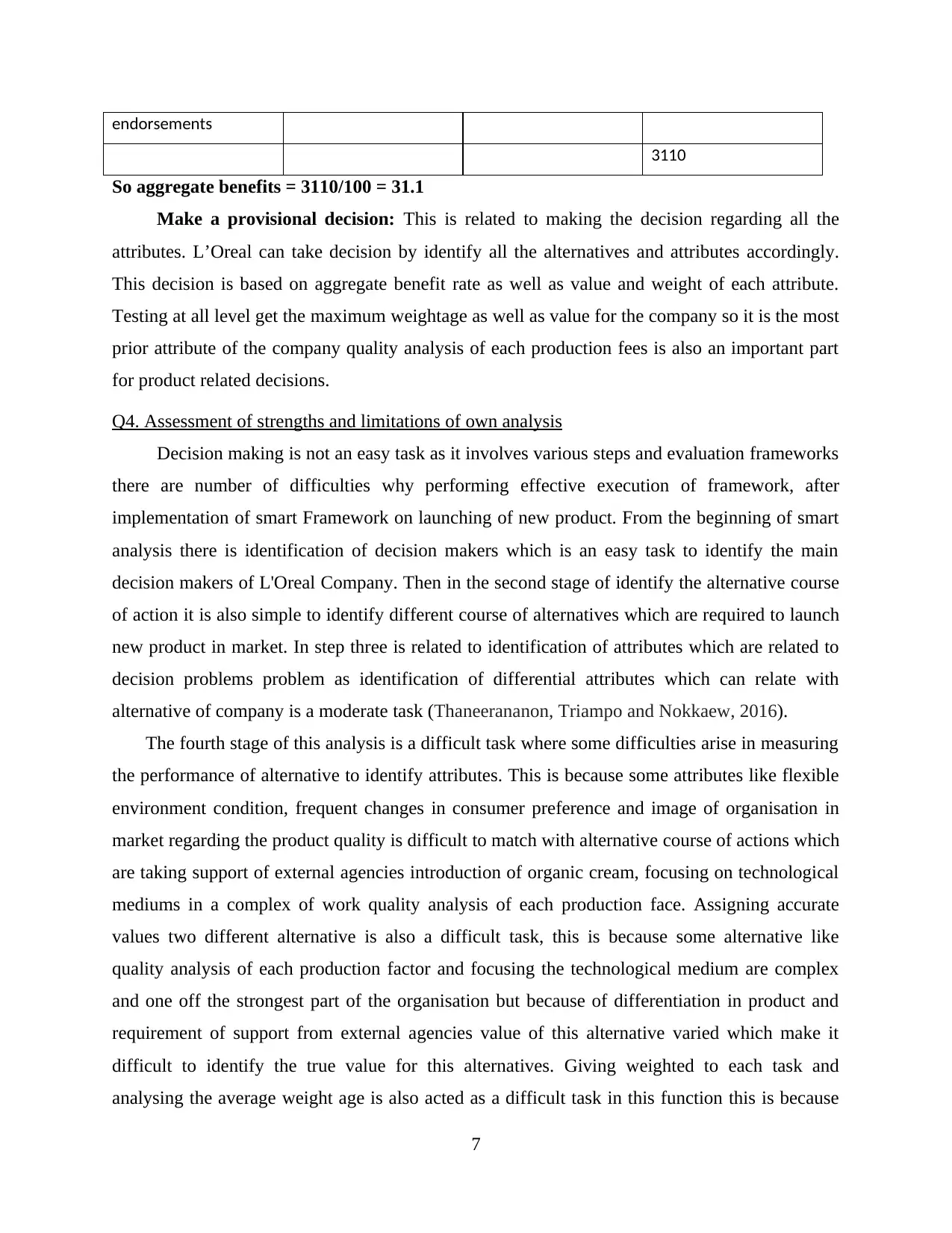
endorsements
3110
So aggregate benefits = 3110/100 = 31.1
Make a provisional decision: This is related to making the decision regarding all the
attributes. L’Oreal can take decision by identify all the alternatives and attributes accordingly.
This decision is based on aggregate benefit rate as well as value and weight of each attribute.
Testing at all level get the maximum weightage as well as value for the company so it is the most
prior attribute of the company quality analysis of each production fees is also an important part
for product related decisions.
Q4. Assessment of strengths and limitations of own analysis
Decision making is not an easy task as it involves various steps and evaluation frameworks
there are number of difficulties why performing effective execution of framework, after
implementation of smart Framework on launching of new product. From the beginning of smart
analysis there is identification of decision makers which is an easy task to identify the main
decision makers of L'Oreal Company. Then in the second stage of identify the alternative course
of action it is also simple to identify different course of alternatives which are required to launch
new product in market. In step three is related to identification of attributes which are related to
decision problems problem as identification of differential attributes which can relate with
alternative of company is a moderate task (Thaneerananon, Triampo and Nokkaew, 2016).
The fourth stage of this analysis is a difficult task where some difficulties arise in measuring
the performance of alternative to identify attributes. This is because some attributes like flexible
environment condition, frequent changes in consumer preference and image of organisation in
market regarding the product quality is difficult to match with alternative course of actions which
are taking support of external agencies introduction of organic cream, focusing on technological
mediums in a complex of work quality analysis of each production face. Assigning accurate
values two different alternative is also a difficult task, this is because some alternative like
quality analysis of each production factor and focusing the technological medium are complex
and one off the strongest part of the organisation but because of differentiation in product and
requirement of support from external agencies value of this alternative varied which make it
difficult to identify the true value for this alternatives. Giving weighted to each task and
analysing the average weight age is also acted as a difficult task in this function this is because
7
3110
So aggregate benefits = 3110/100 = 31.1
Make a provisional decision: This is related to making the decision regarding all the
attributes. L’Oreal can take decision by identify all the alternatives and attributes accordingly.
This decision is based on aggregate benefit rate as well as value and weight of each attribute.
Testing at all level get the maximum weightage as well as value for the company so it is the most
prior attribute of the company quality analysis of each production fees is also an important part
for product related decisions.
Q4. Assessment of strengths and limitations of own analysis
Decision making is not an easy task as it involves various steps and evaluation frameworks
there are number of difficulties why performing effective execution of framework, after
implementation of smart Framework on launching of new product. From the beginning of smart
analysis there is identification of decision makers which is an easy task to identify the main
decision makers of L'Oreal Company. Then in the second stage of identify the alternative course
of action it is also simple to identify different course of alternatives which are required to launch
new product in market. In step three is related to identification of attributes which are related to
decision problems problem as identification of differential attributes which can relate with
alternative of company is a moderate task (Thaneerananon, Triampo and Nokkaew, 2016).
The fourth stage of this analysis is a difficult task where some difficulties arise in measuring
the performance of alternative to identify attributes. This is because some attributes like flexible
environment condition, frequent changes in consumer preference and image of organisation in
market regarding the product quality is difficult to match with alternative course of actions which
are taking support of external agencies introduction of organic cream, focusing on technological
mediums in a complex of work quality analysis of each production face. Assigning accurate
values two different alternative is also a difficult task, this is because some alternative like
quality analysis of each production factor and focusing the technological medium are complex
and one off the strongest part of the organisation but because of differentiation in product and
requirement of support from external agencies value of this alternative varied which make it
difficult to identify the true value for this alternatives. Giving weighted to each task and
analysing the average weight age is also acted as a difficult task in this function this is because
7
Secure Best Marks with AI Grader
Need help grading? Try our AI Grader for instant feedback on your assignments.
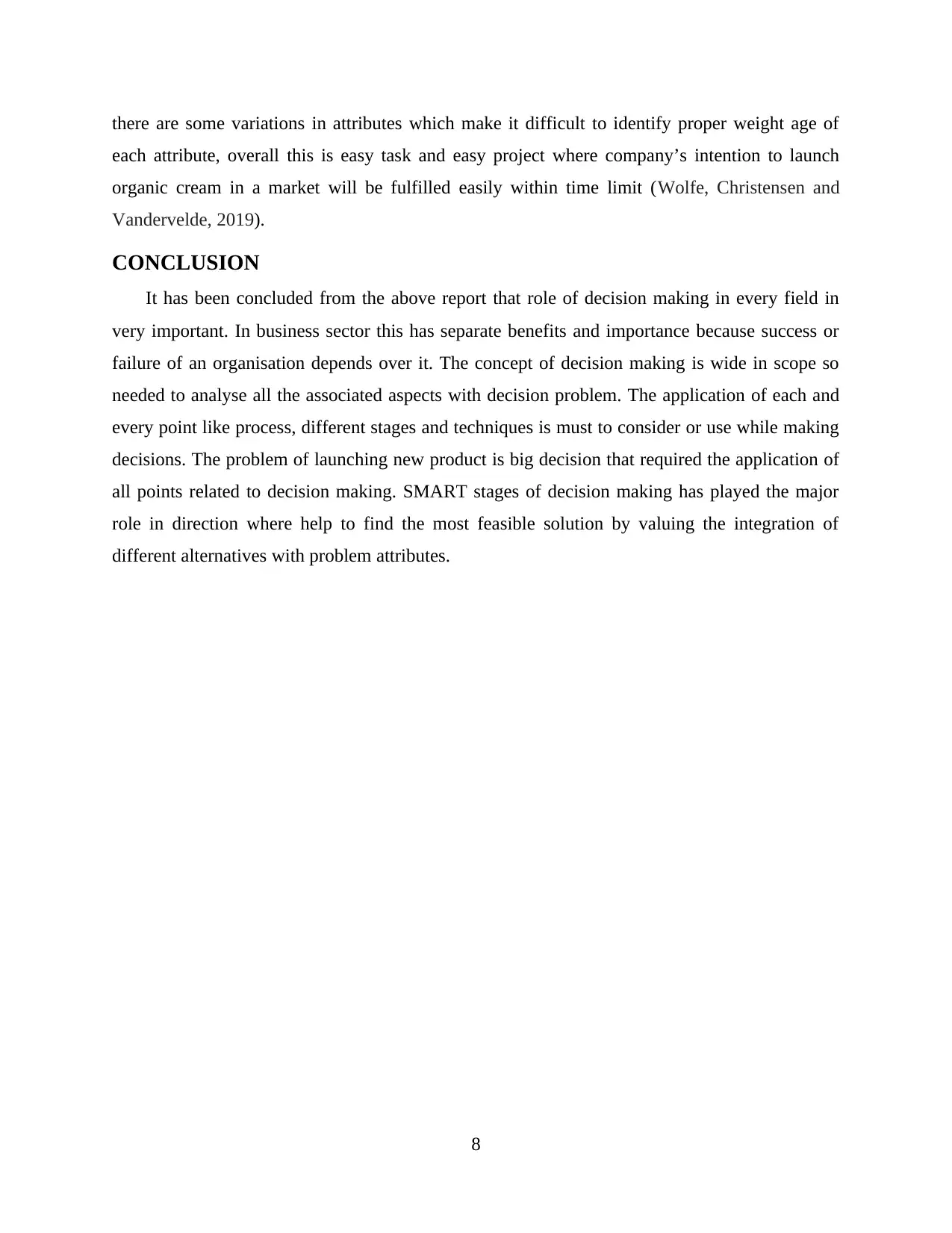
there are some variations in attributes which make it difficult to identify proper weight age of
each attribute, overall this is easy task and easy project where company’s intention to launch
organic cream in a market will be fulfilled easily within time limit (Wolfe, Christensen and
Vandervelde, 2019).
CONCLUSION
It has been concluded from the above report that role of decision making in every field in
very important. In business sector this has separate benefits and importance because success or
failure of an organisation depends over it. The concept of decision making is wide in scope so
needed to analyse all the associated aspects with decision problem. The application of each and
every point like process, different stages and techniques is must to consider or use while making
decisions. The problem of launching new product is big decision that required the application of
all points related to decision making. SMART stages of decision making has played the major
role in direction where help to find the most feasible solution by valuing the integration of
different alternatives with problem attributes.
8
each attribute, overall this is easy task and easy project where company’s intention to launch
organic cream in a market will be fulfilled easily within time limit (Wolfe, Christensen and
Vandervelde, 2019).
CONCLUSION
It has been concluded from the above report that role of decision making in every field in
very important. In business sector this has separate benefits and importance because success or
failure of an organisation depends over it. The concept of decision making is wide in scope so
needed to analyse all the associated aspects with decision problem. The application of each and
every point like process, different stages and techniques is must to consider or use while making
decisions. The problem of launching new product is big decision that required the application of
all points related to decision making. SMART stages of decision making has played the major
role in direction where help to find the most feasible solution by valuing the integration of
different alternatives with problem attributes.
8
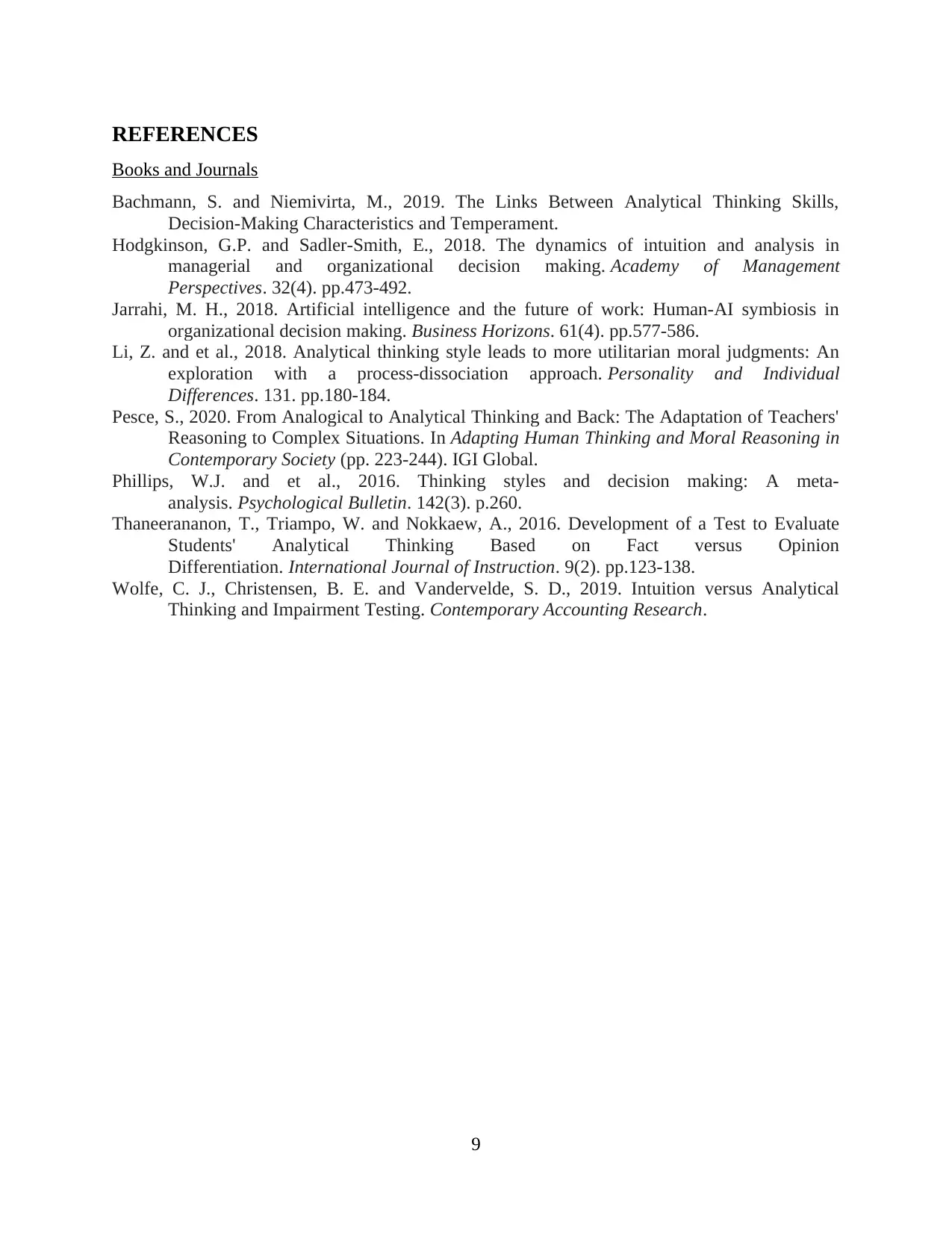
REFERENCES
Books and Journals
Bachmann, S. and Niemivirta, M., 2019. The Links Between Analytical Thinking Skills,
Decision-Making Characteristics and Temperament.
Hodgkinson, G.P. and Sadler-Smith, E., 2018. The dynamics of intuition and analysis in
managerial and organizational decision making. Academy of Management
Perspectives. 32(4). pp.473-492.
Jarrahi, M. H., 2018. Artificial intelligence and the future of work: Human-AI symbiosis in
organizational decision making. Business Horizons. 61(4). pp.577-586.
Li, Z. and et al., 2018. Analytical thinking style leads to more utilitarian moral judgments: An
exploration with a process-dissociation approach. Personality and Individual
Differences. 131. pp.180-184.
Pesce, S., 2020. From Analogical to Analytical Thinking and Back: The Adaptation of Teachers'
Reasoning to Complex Situations. In Adapting Human Thinking and Moral Reasoning in
Contemporary Society (pp. 223-244). IGI Global.
Phillips, W.J. and et al., 2016. Thinking styles and decision making: A meta-
analysis. Psychological Bulletin. 142(3). p.260.
Thaneerananon, T., Triampo, W. and Nokkaew, A., 2016. Development of a Test to Evaluate
Students' Analytical Thinking Based on Fact versus Opinion
Differentiation. International Journal of Instruction. 9(2). pp.123-138.
Wolfe, C. J., Christensen, B. E. and Vandervelde, S. D., 2019. Intuition versus Analytical
Thinking and Impairment Testing. Contemporary Accounting Research.
9
Books and Journals
Bachmann, S. and Niemivirta, M., 2019. The Links Between Analytical Thinking Skills,
Decision-Making Characteristics and Temperament.
Hodgkinson, G.P. and Sadler-Smith, E., 2018. The dynamics of intuition and analysis in
managerial and organizational decision making. Academy of Management
Perspectives. 32(4). pp.473-492.
Jarrahi, M. H., 2018. Artificial intelligence and the future of work: Human-AI symbiosis in
organizational decision making. Business Horizons. 61(4). pp.577-586.
Li, Z. and et al., 2018. Analytical thinking style leads to more utilitarian moral judgments: An
exploration with a process-dissociation approach. Personality and Individual
Differences. 131. pp.180-184.
Pesce, S., 2020. From Analogical to Analytical Thinking and Back: The Adaptation of Teachers'
Reasoning to Complex Situations. In Adapting Human Thinking and Moral Reasoning in
Contemporary Society (pp. 223-244). IGI Global.
Phillips, W.J. and et al., 2016. Thinking styles and decision making: A meta-
analysis. Psychological Bulletin. 142(3). p.260.
Thaneerananon, T., Triampo, W. and Nokkaew, A., 2016. Development of a Test to Evaluate
Students' Analytical Thinking Based on Fact versus Opinion
Differentiation. International Journal of Instruction. 9(2). pp.123-138.
Wolfe, C. J., Christensen, B. E. and Vandervelde, S. D., 2019. Intuition versus Analytical
Thinking and Impairment Testing. Contemporary Accounting Research.
9
1 out of 12
Related Documents
Your All-in-One AI-Powered Toolkit for Academic Success.
+13062052269
info@desklib.com
Available 24*7 on WhatsApp / Email
![[object Object]](/_next/static/media/star-bottom.7253800d.svg)
Unlock your academic potential
© 2024 | Zucol Services PVT LTD | All rights reserved.




